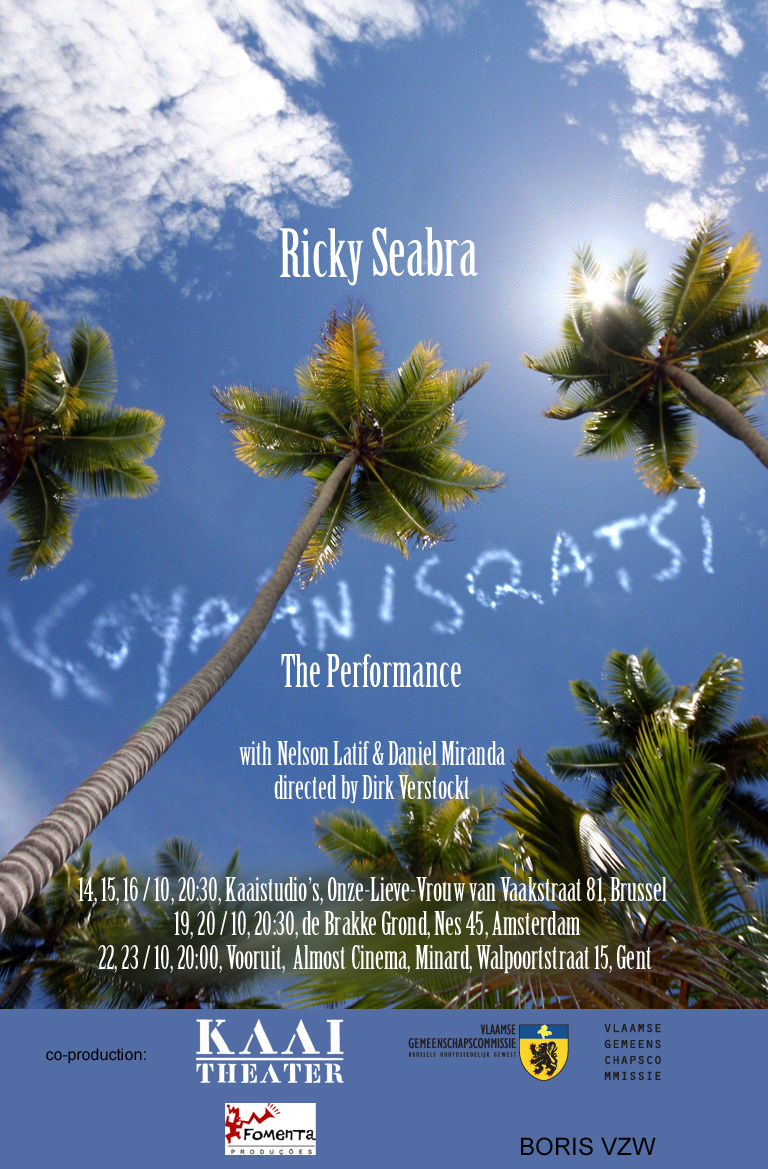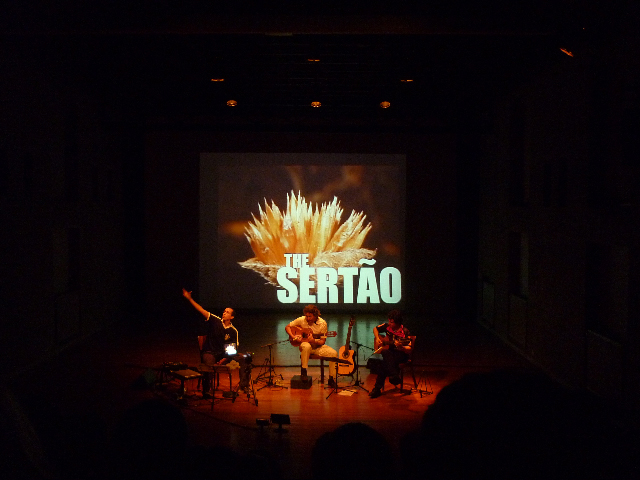|
|
American-Brazilian artist Ricky Seabra and Belgian-Brussels director Dirk Verstockt delve deep into heartland Earth |
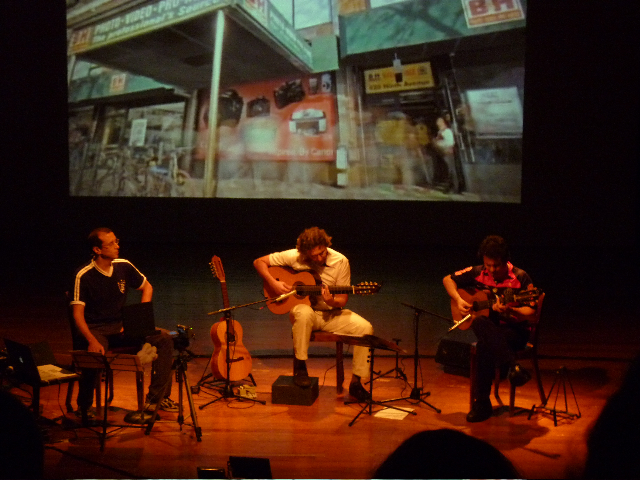 |
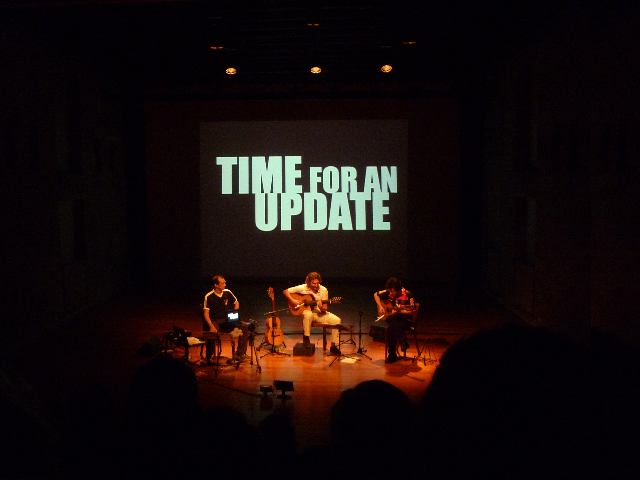 |
|
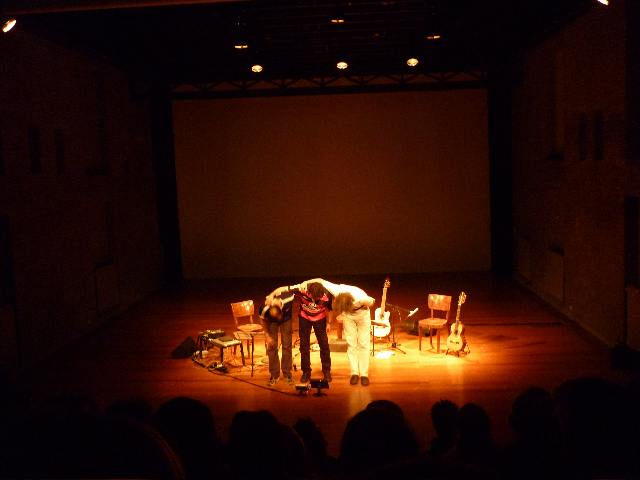 |
Some images from the premiere at KaaiStudios in Brussels. Photos by Fabi Auad.
Ricky Seabra on the project: |
The film as equation:
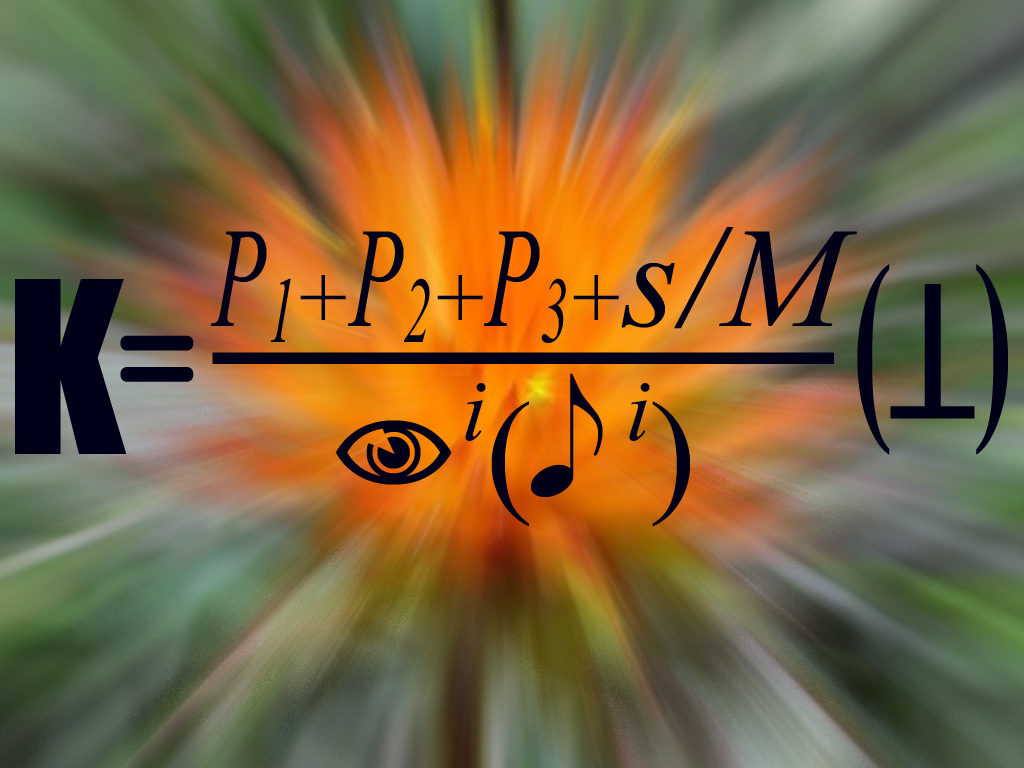
or:
Koyaanisqatsi = Prophecy 1 + Prophecy 2 + Prophecy 3 + Statement on Modernism over
IMAGE to the power of innovation times SOUND to the power of innovation
times Contradiction.
Biographies Dirk Verstockt works as theatermaker, director, mentor, curator, writer, organiser, lecturer, moderator,... mostly within Performing Arts. Currently he is guest professor and mentor for the Master Drama at Rits, Brussels and as personal advisor in DasArts, Amsterdam. He works mostly for Boris vzw, a Brussels based international arts organisation focusing on creation, production and support for performing arts and theatre. In the past he worked for, amongst others, Kaaitheater, VTI, Beursschouwburg, kc nOna, dAda (www.dadatoneel.be), LOD and KVS. Nelson Latif, Cavaquinho and acoustic guitar player, formed his musical identity in the legendary jazz scene of 1980’s São Paulo. With roots in choro and jazz, Latif merges Brazilian styles and a classical guitar technique with diverse musical influences. In his melodic phrasing one hears bebop and Brazilian syncopations, and in his virtuosity the energy of flamenco. Latif started his studies at the age of fourteen. During the 90’s he moved to Amsterdam and started performing on the cavaquinho, an instrument that has since become his trademark. Latif returned to Brazil in 2001, where he formed Trio Baru with Fernando Corbal and Bosco Oliveira. Since then, Latif has performed as a soloist as well as in collaboration with various artists, such as the multi-instrumentalist Carlinhos Antunes, and Ustad Zamir Khan, sitar and tabla player, of the legendary Indian musical family. In 2005 Latif recorded the CD Choro, Samba e Afins, together with Dutch guitarist Joeri de Graaf. This recording started off the Choramundo Project, uniting musicians from Holland, Suriname and Brazil. Daniel Miranda began his professional solo career at the age of 16. In 1997, with Paulo Sá (Mandolin) and Henrique Drach (violin), he created the musical chamber ensemble RIO TRIO. They recorded a CD and performed numerous concerts and workshops in Brasil and the United States. Also in the US, Mirande has participated as a teacher and interpreter at the international conference for Mandolin, at San Diego, CA, and also in Montana, with Bozeman’s Montana Mandolin Orchestra. In 2001, he recorded the CD RENCONTRE, with the participation of the Belgian-Irish guitarist Frankie Rose. In 2002, Miranda became a guitar and harmonics teacher at the VILLA-LOBOS school in Rio de Janeiro. In 2003, in Mons (Belgium), he joined the spectacle Si c'est chanté, c'est pas perdu (If it is sung, it’s not lost), under the musical direction of Pascal Charpentier, then recorded a CD with the ensemble. In 2005-2006, he recorded, as a guitarist and composer, three songs for the compilation of the broadcast Le monde est un village (The world is a village), presented by RTBF’s Didier Melon. He also published his first solo album, called Bienvenue, producted by IGLOO (Belgium). |
Credits |
Analysis: Benny Haesebrouck on "Koyaanisqatsi The Performance" Godfrey Reggio and Philip Glass Koyaanisqatsi worked six years long. The film was a juxtaposition of image and sound, and poetry of technology, of man and nature. Endlessly manipulated images of planes and bombs, of a fatal and derelict modernism blended with the natural beauty of American landscapes. The film showed an almost hypnotically analytical and the destruction of mankind and the planet, and exercised a not inconsiderable influence on the then upcoming wave of film and music talent. A generation was formed, created a new visual culture. The apocalyptic message of the film, however, was lost in the corruption of diagnostic images and techniques. The visual beauty of Koyaanisqatsi was adopted and internalized by the advertising and music industries. Slow motion and time lapse sequences suddenly become part of popular visual culture. Traffic, industrial operations, wasted energy, overpopulation, megalomaniac buildings, we recognize these hyper aesthetic and manipulated images from the consumer culture of cosmetics advertisements, video clips and even ordinary sitcoms. What remains is the purely visual legacy mercilessly by the mill mass was achieved. Images, techniques and soundtrack by Philip Glass, everything was borrowed and sold without the original message and the initial intention of the film stand still. Koyaanisqatsi went through an over-consumption to mean the exact opposite than the idea, the idea that Reggio and Glass last six years were meticulous in breeding. The film, images, music, everything was pushed back without hesitation uitgehoerd to virtually all interested parties, something Ricky Seabra therefore a kind of meta form sets forth. He shows how Madonna Ray of Light and the Spice Girls in 2 Become 1 dance against a background that is essentially the end of the world shows a background that his message long lost saw, and now only serves as a postmodernist wall paper. Nature shudders, they laugh. The future character of the film was perverted into a purely visual take on the prophecy. Ricky Seabra denounces this technical formalism and engaging in dialogue. He combines authenticity and tradition of powerful, Reggio related images on a Brazilian guitar music graft by rural caipira instruments like the viola and choro violão besides the commercialized image Koyaanisqatsi significance of place. Japanese mass moves towards the simulation of waves in what can best be described as an Asian variation on an overcrowded Sunparks given. The masses in the pool, packed like sardines, distorted into a wavy sea of ??people that water has no place. Head after head, body after body mass bobbing on the simulated waves and it becomes clear what Ricky Seabra am suggesting here: the almost perverse accumulation in the complex shows how Japanese people know about them to transform into an amusing thought. The problem is forgotten and converted into a game. Ignorance trumps. Seabra pulls out the fateful indifference of humans to adapt, a phenomenon he calls himself the Dodo-effect. The dodo, discovered by settlers on the island of Mauritius, died not so long ago and had a beautiful bird songs. Species disappear, trees perish: we consume nature of the earth can give us nothing until we the song of the dodo and the color of the sky forgotten. For there is one day that we pallet of green foliage or red dawn on the horizon will no longer see. We accept this without much, because man is characterized by indifference and a great ability to adapt, an extremely dangerous combination. We held each morning on an inferior version of the world. And we never look at. Ricky Seabra exercised in other words, what performance Reggio and Glass tried to film the crowd wake up before it's too late, before we completely consume mother earth, for life has no meaning. But he goes on simultaneously. While the film raises only pessimistic, Ricky has ventured to a number of optimistic responses and ideas to install a positive, wereldaffirmerende view. Near his residence in Brazil, a growing number Talipot palms, trees somewhere between eighty and their thirtieth birthday blossom and then die off. On his way to work, the Brazilian this spectacle every day while watching one. The last act of the tree, levensaffirmerende a final act before dying. The beauty of the deterrent, the sublime of death. How many other Brazilians view these trees and realize that this is a final act of life means, a final contribution of this private piece of nature to man. The least we can do in return, Seabra said, is to organize a dignified farewell. The tree, horizontally and at a funeral ceremony in which people on the street stop briefly at the thought of life, the importance of death and the rise and decay of nature. Himself briefly seen as part of and in harmony with nature. The film Koyaanisqatsi contains no dialogue, except three Hopi - an Indian tribe from northeastern Arizona - statements at the end, three sentences with a predictive even in the twenty-first century truth have lost nothing. What's more, Seabra shows how the three Hopi prophecies have a frighteningly topical nature spells by connecting to three relatively recent events. This enables us to spell "If we dig precious things from the land, we want invite disaster" the mine disaster in Chile coupling, and can "A container of ashes Might one day be thrown from the sky, Which Could burn the land and boil the Ocean "refer to one of the many plane crashes over the Atlantic Ocean. By far the most interesting prophecy in connection with the performance of Ricky Seabra, however: "Near the Day of Purification, There Will Be cobwebs spun back and Forth in the sky." It was great ignorance and disbelief when he first Saturday in Ghent spent. He looked up and saw dozens of trace moisture in the air from the engines of aircraft. This was not a blue-red sky, but a dirty, perverted interpretation of a sunset. He handled this outrage in his performance through a clear blue sky to go to edit a grid of random tracks visible condensation and the air loses his virginity. Each pair represents white traces Seabra an ecological pollution of one hundred trees, while the average for each pair of Belgian white traces a holiday means an escapist exodus to a tropical resort, it may just dreaming. Seabra combines questions and answers, ancient prophecies and modern ideas. The Hopi Indians held during their long treks often take a few days to stop their souls to give them a chance to catch up and reunite with the body in advance. The condensation of an aircraft tracks symbolize the speed with which people today from one place to another travels, like the fast motion images in Koyaanisqatsi denounced the speed of society. Seabra suggests that the tail of the helicopter to a kind of contemplative, transparent space to install (thinking of galleons in the maritime history in which the captain had a balcony behind the ship) from which the passenger behind traveling soul can watch. It's just these juxtapositions of man and nature, tradition and modernity that also the musical aspect of the performance space. Koyaanisqatsi is the minimum for half the power of the minimalist music of Philip Glass, a fact that Seabra did not want to deny it to the shelves in translating the cult film. Based on two traditional Brazilian guitars, viola violão caipira and choro, the soundtrack to Glass reinterpreted within a discourse of tradition versus modernity, the Brazilian countryside against the danger of the postmodern era. At one point creates another paradox in the show, a paradox that the intention behind the film and narrative of Ricky Seabra here threatens to disrupt. Indeed, the preparation of the performance shows at least one contradictory feelings on the audience: Seabra place an iPad, the latest gadget from Apple, for a camera. This camera focuses in turn the tablet screen iPad and projecting this image on a large screen behind the performers, the cinema screen for the spectators. First is the opposition to ultra-modern technology from America and peasant tradition of Brazil is in line with the performance, namely the juxtaposition of tradition and modernity, the wild and transferred consumed. But then Ricky Seabra shows positive, optimistic ideas to save the world on its iPad, while for many this ultramodern device just symbolizes everything that is wrong in contemporary mass culture. Asked whether this was a conscious choice, Seabra states that we will not succeed in saving the nature and the awareness of people without the help of technology. Technology is indeed all around us, why should we decide not to use? It makes our lives easier, and it provides us with the means to create new ideas and impulses that may ultimately contribute to a more sustainable vision of the world, nature and humanity. Indirectly Here he paraphrases the director of Koyaanisqatsi, Godfrey Reggio in a documentary about the film: "[...] Thesis films have never leg about the impact of technology, industry, or on people. That it's been everyone: politics, education, things of the financial structure, the nation state structure, language, the culture, religion, exists if thats all the within-host of technology. So it's not the security or, it's that everything exists within-technology. It's Not That We use technology, we live technology. Technology HAS become as ubiquitous as the air we breathe ... " The images get through the technological medium is a renewed interest, the corruption of pop culture is deconstructed in the ten-inch screen of the iPad. Koyaanisqatsi, literally a way of life that requires a different way of life is thus freed from the tangle of mass and energy can be regained her message to the world. This text was written as part of a collaboration between Vooruit and subvakgroep Stage and Medial Arts of Ghent University. Analysis: Anne Watthée on 'Koyaanisqatsi The Performance' - From Ecological Disaster to Elation In his most recent show conjures up the US-Brazilian "raconteurs" Ricky Seabra, in cooperation with the Brussels director Dirk Verstockt, the cult film Koyaanisqatsi, Life Out of Balance into a performance. This classic film by director Godfrey Reggio and cinematographer Ron Fricke led the early '80s for a lot of commotion by his heavily laden, ecological message. The world had in fact urgent need for "another way of living". Despite a major social commitment Seabra's performances remain airy and even comical. The following analysis seeks to examine how the performer succeeds on the basis of the revival of a warning, negative message, but creating a positive image. A sad repetition In the first part of Seabra's performance is a certain universal sadness raised. The initial message of the film is lost by countless revivals and the (environmental) situation 30 years after the film release only worsened. Seabra considers that it is high time to react, but do not succeed in escaping the postmodernist repeat. The artist confronts the viewer from the very beginning of its revival with images that explore the cultural "repetition compulsion". He shows a number of scenes similar motive to absurd to repeat. We see how a choreography that comes from the 60s, will be captured in a video clip of Beyonce. Then the clip a picture within a picture when you get to see a home movie in which a baby for the same television clip dancing. This baby is in turn parodied by a grown man, dressed in a diaper, the baby imitates while viewing the clip. Seabra places these four images side by side and thus emphasizes the absurd (and even comical) aspect of the endless rerun, which post-modernist artist himself as he falls prey. The "magic herb" of the world In a first prophecy suggests the performer a utopian world where all roads through the trunk of trees are built. A second and third prophecy show how the world can be saved. We were able to save the Amazon forest by a large ontkoeingsonderneming, and even saved from global warming by guitarist penguins in diamonds suits. The fantasy stories, which the classical hierarchy of living beings dumb down, are so unreal that they are humorous. Finally venturing Seabra themselves to a final prophecy, which trees would get an honorable state funeral. He honors the inevitable death of our ecology, because it is natural. Seabra realizes we can not escape death, and thus chooses to make it worthwhile to accept failure. Koyaanisqatsi - The performance builds to an ecological consciousness, already in the 80s was raised, but since then no progress has known. On the contrary. Within the context of the current ecological crisis and the current ecotendens, Seabra succeeds in his audience back to "enchant". Against the pessimistic mindset of the demise of the world, the performer places a positive answer he reached on the basis of humor and dignity. The final prophecy shows indeed an acceptance of universal human failing, but in an honorable and elegant manner. Ricky Seabra succeeds in the most desperate situation in a positive light. This shows Seabra's unlikely Brazilian energy and vitality. 1. "" Koyaanisqatsi "in the Hopi language means:" a crazy life "," A Life That calls for another way of living "," a life out of balance. "" From: Koyaanisqatsi, Life Out of Balance, United States America, Godfery Reggio, 1982. This text was written as part of a collaboration between Vooruit and subvakgroep Stage and Medial Arts of Ghent University. More comments: Dear Ricky, Thanks for sending me the DVDs. Both were of good quality, worked well and gave me access to you beautiful and surprising work. I watched "Koyaanisqatsi The Performance" twice. The first time driven by curiosity, discovering surprises at each step of the simple and solid structure. The second time I enjoyed and savored the metaphors built by image and word which reveal your great heart - the heart of a poet. Thank you, friend, for the exemplary performance. Um grande abraço Sebastião Milaré A sensitive, kind performance with necessary humor, lightness and melancholy. Dirk, Bedankt voor de zachte voorstelling Koyaanisqatsi the performance, verbindt voor mij niet alleen indringend, bijna absoluut, vanuit mijn jeugd een weer tevoorschijn gehaald, een haast arrogant cinematografisch beeld, wat zomaar ff en fr, pauze, stop, symboliseert in on-ontologische zin en door jouw als artistieke mogelijkheid geconceptualiseerd in een interdisciplinaire exercitie tussen de hyper vloeibaarheiden van het performatieve in theatrale zin, maar staat in haar soberheid en kwetsbaarheid heel mooi te zijn! |
|
Performances: 2010 |
